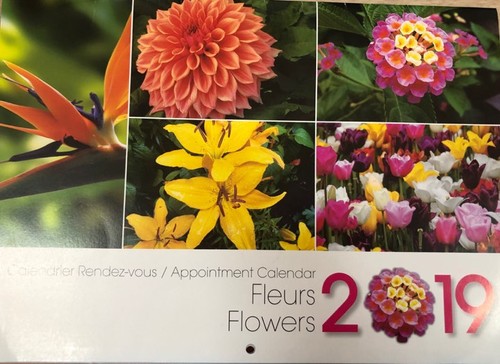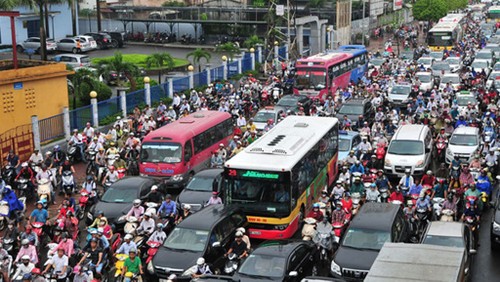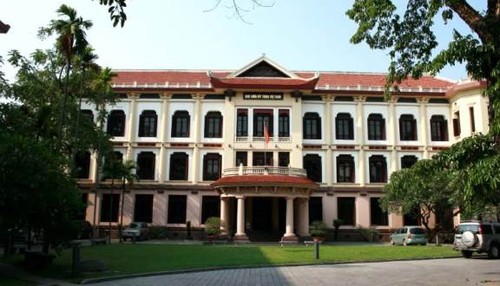A: Christmas and New Year are coming soon and the festive spirit is everywhere. Here at VOV5, we have been receiving season greetings from our listeners around the world.
B: This week we received a calendar with beautiful flowers from Roger Russel of Canada. In his letter he wrote: “I am very happy to send you this 2019 Calendar from Canada. I hope you will like it. I will send you some reception reports for shortwave broadcasts received in Canada.”
 VOV receives a beautiful calendar from Roger Russel of Canada VOV receives a beautiful calendar from Roger Russel of Canada |
A: Thank you very much, Mr. Russel, for your continued support for VOV. We like your calendar a lot and have hung it on our office wall as we did in previously. We’ll confirm with a QSL card your report for our program on November 6th from 00:01 to 00:27 UTC on the frequency of 7315 khz. We are also sending out New Year’s cards and calendars to our listeners around the world. We hope they will reach you soon.
B: We’d like to thank Richard Chen of Trinidad & Tobago, one of our regular listeners, for sending us a sparkling Christmas greeting card. Your support for VOV’s shortwave broadcasts and website has been a great source of encouragement for us. We’re very happy that the number of our listeners has increased every year. Listeners support our shortwave broadcast, our website and our mobile app and interact with us on our Facebook fanpage at VOV5 English Section. We look forward to more feedback and comments from you to further improve our service.
A: Here’s a letter from Bert Sing of Australia, we haven’t heard from for a long time. He wrote: “It has been wonderful listening to your broadcast in English on Monday 29th October 2018 from 10:00 to 10:28 UTC on the frequency of 12020 khz on a Tecsun 600 using an outside antenna. It’s a very interesting program.”
B: Thank you, Mr. Sing, for your feedback. We’ll send you a QSL card to confirm your report.
A: Commenting on our December 5 program, Karuna Kanta Pal of India wrote: “I am a regular listener and I like the news and the Letter Box program very much. While I was in Tokyo, August 2018 for two weeks, I heard no vehicle horns, saw automatic toll gates and felt no speed bumps on the road. What about the traffic in Hanoi? I wish all of you a very happy Christmas and a Happy New Year 2019.”
 Traffic in Hanoi Traffic in Hanoi |
B: Motorbikes are the most popular means of transportation in Vietnam. Motorbike sales in Vietnam rose to 3.12 million units last year, a year-on-year increase of 4.8%, according to the Vietnam Association of Motorcycle Manufacturers. Vietnam has a population of 92 million people who won 45 million motorbikes, according to the Ministry of Transport.
A: Undeniably motorbikes play an important role in all aspects of everyday life in Vietnam, particularly in the cities. For example, in Hanoi, a city of more than 5 million motorbikes, everyone uses a motorbike to get around in the tiny streets and alleys. And the number of motorbikes is growing rapidly.
B: During peak hours on weekends and holidays, the number of motorbikes is overwhelming. Traffic jams are common at rush hour.
A: Mr. Muhammad Shamim of India listened to our broadcast on December 5th from 16:00 to 16:30 on the frequency of 7220 khz and reported good reception in his area. This week, Mr. Shamim had a question about art museums in Vietnam.
B: The Vietnam National Museum of Fine Arts is located in Hanoi. It is a museum showcases Vietnam's fine arts in different historical periods.
A: Much of the 20th century art presented in the museum is concerned with folk narratives of a nation at war. The collection draws on themes of martyrdom, patriotism, military strategy and overcoming enemy incursion.
 Vietnam National Museum of Fine Arts Vietnam National Museum of Fine Arts |
B: The museum has a small collection of late 20th and early 21st century painting, including works by artists exploring abstraction and abstract impressionism.
A: The Vietnam National Museum of Fine Arts has become a prime tourist destination in Hanoi. The museum represents the history of fine arts in Vietnam with more than 2,000 items. This museum is both a cultural and an educational institution. With the Ministry of Culture, Sports and Tourism it is responsible for restoring, conserving, and exhibiting ancient artifacts as well as contemporary artwork.
A: The museum attracts visitors for both its art collections and its architecture. It was built in 1930 as a boarding house for French girls studying in Hanoi.
B: In 1966 the building became the museum it is today, exhibiting fine arts with on a total area of 4,200 square meters in Nguyen Thai Hoc street.
A: The building is classical in form but embellished with Vietnamese decorations and details. The interior design contains many Western elements.
B: The collections of ancient antiquities and contemporary art are displayed in two wings, on three floors. The oldest artifacts include sandstone sculptures of the Champa and Funan kingdoms and an elegantly carved Amitabha Buddha produced around 1057. Later works include a huge lacquered wooden Bodhisattva sculpture dating from the sixteenth century.
A: A rich collection of lacquer showing its evolution in Vietnam is the main attraction for many visitors. Sculptures depicting Vietnamese kings and queens as Buddhist deities are delicate and highly refined examples of the use of lacquer in carvings.
A: The remarkable “One Thousand Eyes, One Thousand Arms Guan Yin”, one of the largest and most impressive pieces, is a Goddess with many arms carved in the Hindu style of 1647.
B: Other notable collections are Buddha images in different styles from the late eighteenth century, water colors on the first floor and colorful costumes and decorative art from Vietnam’s ethnic minority groups.
B: Next, we’d like to acknowledge letters and emails from Richard Nowak of the US, Najim Uddin, Abid Hussain Sajid, and Chandani Raj of India, and Muhammad Aqeed Bashir of Pakistan. We welcome your feedback at: English Service, VOVWORLD, the Voice of Vietnam, 45 Ba Trieu Street, Hanoi, Vietnam. Or you can email us at: englishsection@vov.org.vn. You’re invited to visit us online at vovworld.vn, where you can hear both live and recorded programs. Check out our VOV Media App available on both the IOS and Android platform to hear our live broadcasts. We look forward to your feedback on the mobile version of vovworld.vn. Once again, thank you all for listening. Goodbye until next time.